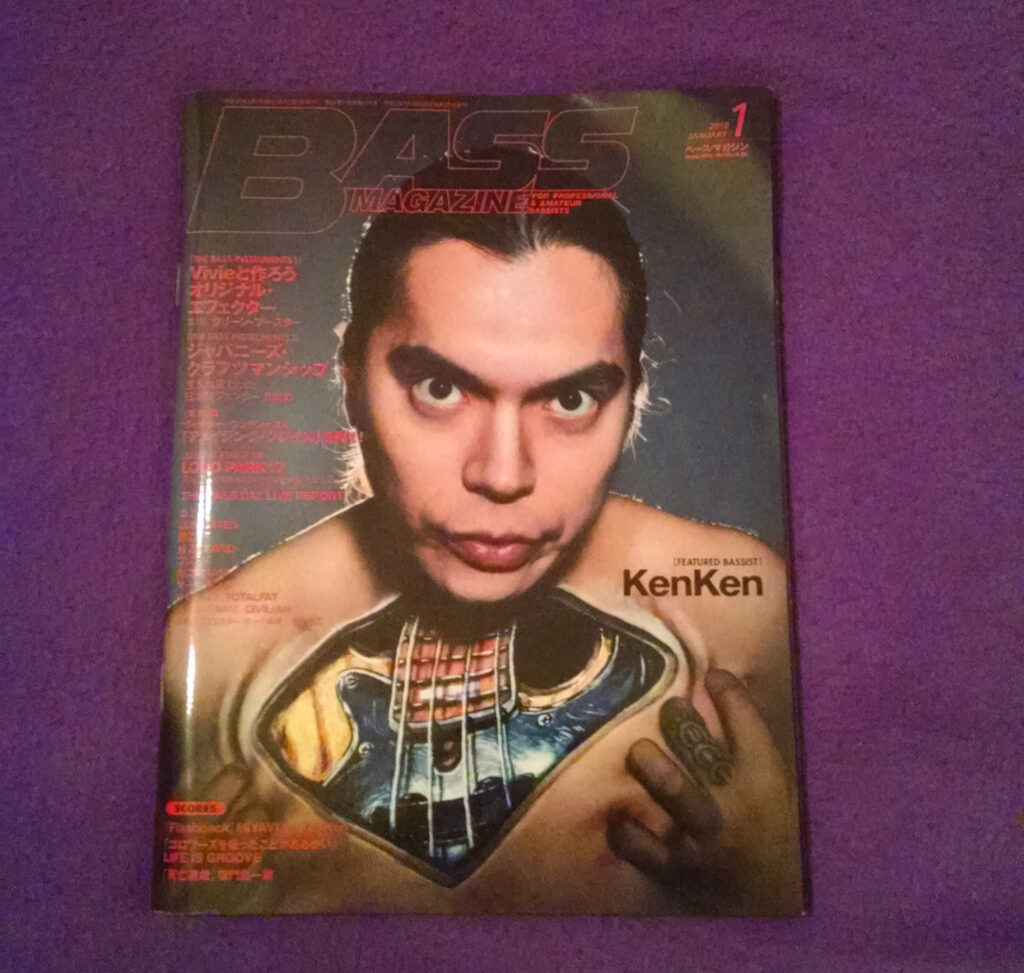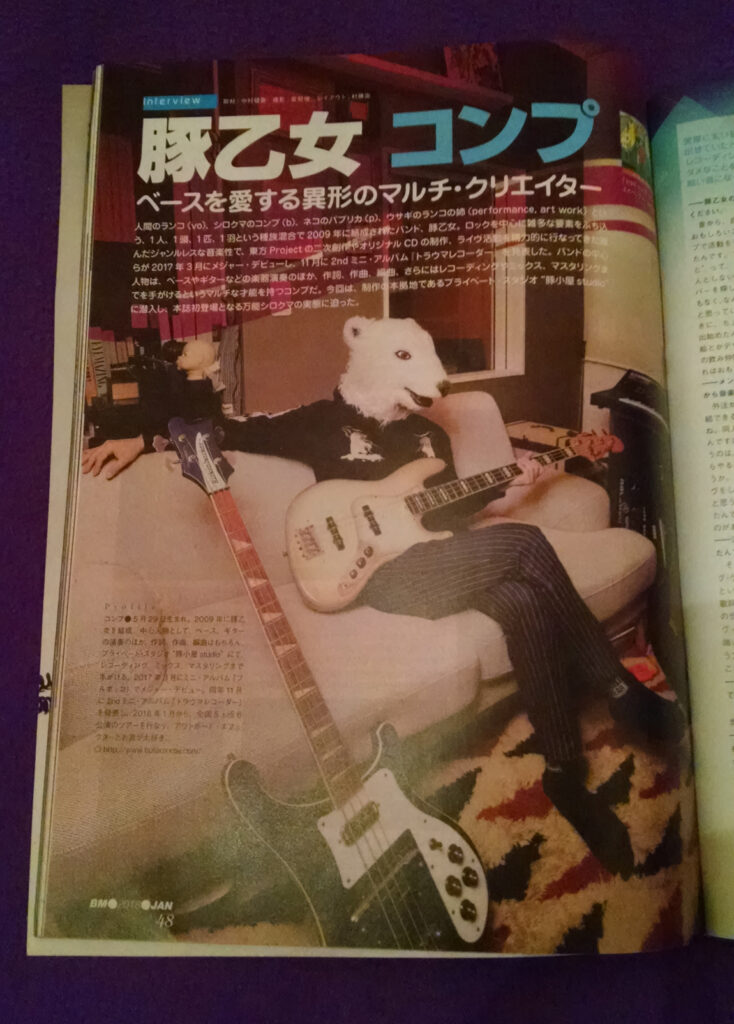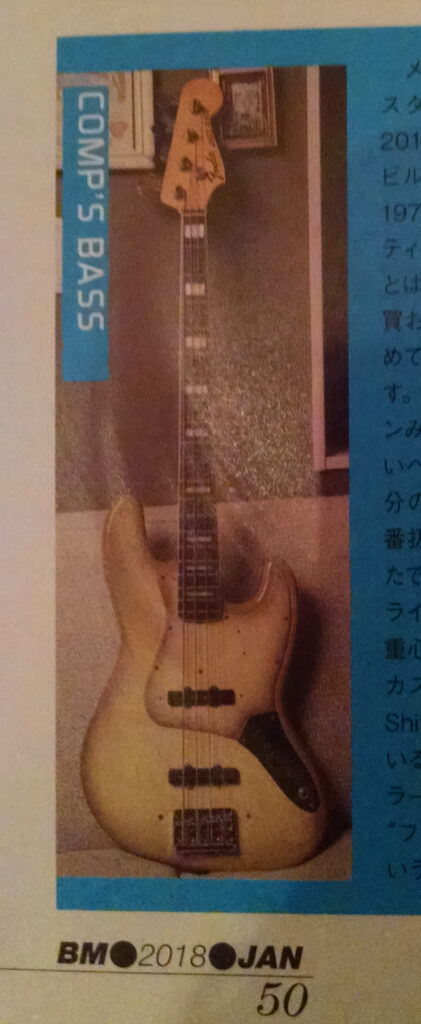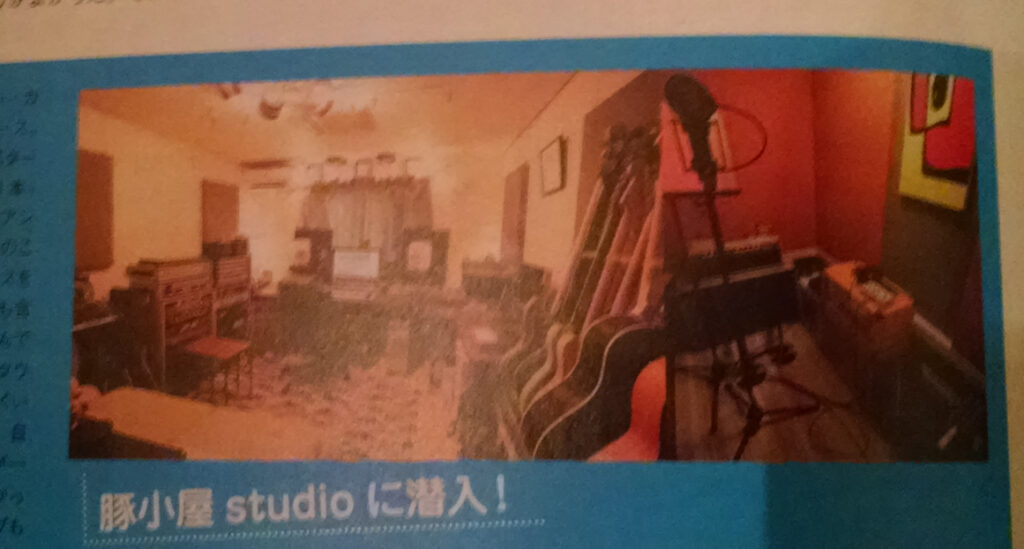Another old interview from the magazines I bought specifically for BUTAOTOME articles! This one focuses on Comp as a bassist, and the bass techniques he used for Trauma Recorder.


A strange-looking multi-creator who loves the bass
A mixed-species group consisting of Ranko (vocals) the human, Comp (bass) the polar bear, Paprika (piano) the cat, and Ranko no Ane (performance, artwork) the rabbit formed a band, BUTAOTOME, in 2009. With a genre-less musical style that incorporates a variety of elements centered on rock, they have been actively involved in Touhou Project derivative works, original CD production, and live activities, made their major debut in March 2017, and released their second mini-album “Trauma Recorder” in November. The core of the band is the multi-talented Comp who, in addition to playing instruments such as bass and guitar, writes, composes, arranges, and even records, mixes, and masters the music. In this issue, we sneaked into the private studio “Butagoya studio” where the production is based, to get a closer look at the all-powerful polar bear, who is making his first appearance in this magazine.
Profile
Comp – Born May 29. He formed BUTAOTOME in 2009. As a core member of the band, he plays bass and guitar, writes lyrics, composes and arranges music, as well as recording, mixing, and mastering in his private studio “Butagoya studio”. They have their major debut in March 2017 with their mini-album “Furubokko”. The 2nd mini-album, “Trauma Recorder”, was released in November of the same year. From January 2018, they will be on tour, with 6 dates in 5 different cities. He loves outboard effectors and alcohol.
Even if I could actually create a thick sound, if I did something wrong on the recording, it would end up sounding thin.
Please tell us how did you form BUTAOTOME.
For a long time, I wanted to be in a group that could do something fun on their own. However, there are some people who are linked to “fun things” and some people who are not, and it wasn’t like I was looking for members all the time, I just kind of thought, “I want to do that”. At that time, Nico Nico Douga started to appear. So, I thought it would be interesting to do something with my drinking buddy Ranko’s sister, who is a painter and designer, and Paprika, a piano player, who was another drinking buddy of mine.
One of the members is in charge of artwork, so were you aiming for an expression other than just music from the beginning?
We didn’t want to outsource anything (laughs), but we wanted to do “something that we could complete all by ourselves”. There are many ways to do doujin music, but the biggest difference between doujin music and indie music is that we do the production first, and when we want to perform live, we do it. It’s more like there’s a production process. I think a lot of indie bands write songs, play shows, and then work on the production. We also wanted to play live, but we wanted to make music and videos first.
You started out in what you call the “Touhou style” of music, right?
Yes, that’s right. They are called “Touhou Arrangements”, and they are arrangements of BGM from a shooting game called Touhou Project. Since they are BGM, the original songs didn’t have any lyrics at all, but I imagined the characters and the world of the game, added lyrics, and made them into vocal songs. “Touhou style” is a culture that started with games and spread to manga doujinshi and music, and the way it spread was interesting, so I thought I’d like to try it.
Did you start making original songs early on?
Around our second year, we started doing originals at the same time.
BUTAOTOME’s music style is quite diverse both in terms of arrangements and originals, and range from rock to jazz, but what kind of music did you have in mind when you first started?
I didn’t have a specific style. For the Touhou arrangements, I tried to create arrangements that would fit the character’s worldview, not only rock but also danceable and jazzy. The original songs were original songs, and we did whatever we wanted to do at the time, regardless of genre.
Comp, what are your own roots?
I was originally a punk kid, and then I went through blues and funk, and then a mixture of various things. I have an older brother who influenced me to listen to old Japanese indie records like Nagom Records, so I guess I have this sense of “anything is interesting” rooted in me. I don’t really have a specific style of playing, either.
What made you start playing the bass?
I’ve always been the type of person who gets bored easily, even when I wanted to draw manga. But I wanted something that I could keep doing. My older brother was a musician, and I wanted to try music, so I tried playing the keyboard, and I even tried playing “jump” instead of drums (laughs), but all of them were boring. But when I tried the bass, I really enjoyed it.
Who are your favorite bassists?
Jaco Pastorius and Larry Graham are big in my mind, both in terms of playing style and personality. I often carry my instrument around with me live, but that’s probably because I know in the back of my mind that Jaco did like that. I’m okay with that.
In terms of players, do you think that jazz/fusion and funk are rather basic?
Well, if I had to pick, I’d say those two, but I also like rock and roll and blues bassists like Tom Hamilton of Aerosmith and Tommy Shannon who played with Stevie Ray Vaughan. On the jazz side, I also like Charles Mingus. So I guess it doesn’t really matter what kind of music they play. I like people who practice hard and try their best to improve their playing.
With BUTAOTOME, you not only play bass, but also write lyrics, compose, arrange, and you are even in charge of recording, mixing, and mastering music, what led you to do something other than being a player?
It’s the same as the style of BUTAOTOME that I mentioned at the beginning. II was wondering if it would be less complicated to outsource/ask someone else to do it, or to do it myself (laughs). I’m the type of person who is impatient and wants to get things done quickly, so I gradually began to think that it would be better to do things on my own, including scheduling. Also, as a player, I’ve always wanted to create a “thick sound”, but even if I could actually create it, if I did something wrong on the recording, it would end up sounding thin. There was a time when I was slightly neurotic about how to convey such things as they were (laughs), and that’s when I became more and more interested in recording.
It’s 100% musicianship.
What were your intentions for your second major mini-album, “Trauma Recorder”?
The previous major release, “Furubokko”, was our first major album, although we had released various CDs as doujin, so I was thinking of something that would be my business card. So, I mixed in some of my past works as well as some of the things that make BUTAOTOME unique, but since this is the second album, I created the songs and arrangements in a way that it’s just the current BUTAOTOME. For me, I think it became more listenable in a good way.
“Trauma Recorder” is a punkish song with a distorted bass sound, but it’s rather high-pitched, isn’t it?
Yes, it is. The last album was surprisingly heavy overall, so I wanted to go a little higher for the next one. I also imagined that the arrangements and playing style for this album would be something that students would want to play at a school festival, so I guess it just naturally came out this way.
How do you record?
I record the bass on the line with just a compressor and preamp, and then I reamp it. I use a Universal Audio 1176AE compressor and a TUBE-TECH MP1A preamp. The amp is an Ampeg B-15N. I don’t use pedals even for distortion sounds, and the B-15N is great for recording with amp distortion because it’s very big and the microphone rides well.
I heard that you like analog effectors, but you don’t use them for the bass?
I don’t use them on my recordings. I do use a Free The Tone BASS BLASTER or something like that when I play live. I have a lot of analog effectors, but most of them are for guitar (laughs). I’ve tried a lot of compact effect compressors for bass, but for recording, I prefer compressors from studio equipment like the 1176.
In the interlude after the first chorus of “Yodare”, there’s a chorus on the bass, right?
That’s the Boss CE-1. It’s a texture that can only be achieved with analog effectors.
The verse of “Yodare” is a funky and groovy play with rests and fills on the basic beat, and the second fill was played in unison with the melody, giving me the impression that it was well thought out.
Many of the detailed phrases are done on the spot while arranging. Here, I wanted the bass to play a bit while keeping the basic beat, and I purposely created gaps for the guitar to cut through. My arrangement method is to create the melody first, then the drums, the guitar, and finally the bass. That’s probably because the bass is my strongest instrument, and I can be more flexible when I feel that “something is missing”. Of course, I have a rough idea of what I want to do before I start working on it.
There’s a high-speed slap riff in “Ikiru no ga Heta na dake”, but it doesn’t have the crispy sound of fusion music, it’s more like a sportish image.
That’s right (laughs). Rather than making my playing sound beautiful, I imagined the tone to be like hitting someone with a goo. (laughs) This song started out with me wanting to make a fast slap song, but even with fast slap, I wanted to do something rumbling, not a solo song with lots of movement.
I thought it was flashy that the last part of the chorus was the only part that had a big grease effect.
I’m also a bassist, but what I really care about is “how to make the song come alive”. To put it in a very unpleasant way, the bass is one of the tools that I use. So in my mind, I don’t think “I want to play like this as a bassist”, but as a songwriter or arranger, “I want the bassist to play like this”. Then, as the song builds up, I decide that “I want the bassist to play with grease at the end”.
So you have a calm and arranger-like perspective. In that sense, the bass in “Zurezure na Hibi” and “Fusoku Hokou” is completely at the bottom, but a player-like perspective would want to play a little more (laughs).
I guess so. (laughs) That’s why I think I have a strong sense of how to improve the music, rather than “how I want to play it”.
Even though it’s the same simple bottom support, “Zurezure na Hibi,” which is played with an eighth root throughout, has a relatively light sound with a little bit of crispness from the pick, while on the other hand “Fusoku Hokou” has a fuller and more robust sound in the low end.
I used the same bass and the same system for all the recordings, and I didn’t make any major changes in the mix, so the difference in the way I play is significant. Of course, the most important thing is that it’s the tone that the music demanded, but this time I played a lot more simply, and maybe subconsciously I thought that the change in tone due to the difference in playing style was one of the ways to express the bass.
The ballad “Fusoku Hokou” could have been written with a melodious backing sung by the bass, but why did you keep it so simple?
Nowadays, listeners listen to music in all kinds of different environments, but I believe that the melody and lyrics are the same no matter how crappy the environment is or how expensive the audio system is. Especially for the ballads, I wanted to let the listener hear the melody and lyrics as much as possible, and naturally, it was better to let the listener hear just them rather than the whole arrangement. So I tried not to interfere with them, but to support them.
It’s a completely music-based perspective, right?
It’s 100% musicianship.
In that sense, the part of this album where you put your bassist’s point of view is the high-speed slap of “Ikiru no ga Heta na dake”?
To put it simply, yes. But actually, it’s “Zurezure na Hibi”. I think a simple eight root pick is the easiest to copy, but in my opinion, it’s very difficult to play.
You can’t fool around with it.
That’s right. The length of the notes, the timing, etc., made me realize once again how difficult it is to play in eighth, and I actually said, “This is difficult~” while recording (laughs).
By the way, do you mainly play with your fingers?
I play with my fingers 90% of the time. On this album, “Trauma Recorder” and “Zurezure na Hibi” are played with a pick.
So, what are your plans for the future?
BUTAOTOME will be going on tour from January, and I’d like to take the time to make a full-length album in 2018. As a bassist, I’m still as dedicated as I’ve always been, so I want to keep practicing so that I can play better and better. I don’t do it from a player’s perspective, so when “I want this kind of play”, I sometimes ask myself to play something I can’t play. It’s a good way to practice to be able to play that reckless thing. But I always wonder “why I thought of this” (laughs).
I feel like that would be more imminent and you would be able to practice and learn more (laughs).
Yes, I have to do it no matter what (laughs). But I also want to do other things in my spare time, like practicing the clicks. In the past, I used to go out while listening to just the clicks, and I would practice getting the 16ths and the backbeats by hand (laughs). I’d like to get back to that kind of thing as well.

Comp’s Bass
His main bass is a Fender Custom Shop Jazz Bass. It was purchased around 2010, and it’s made by master builder Mark Kendrick. The Antigua finish, which was used for a short period of time starting in 1977, is refined. “Without thinking about budget, I decided to buy a bass that would last me a lifetime, so I went to many music stores in Tokyo to try out basses, including jazz basses from the 60s. There were a lot of great basses out there for playing old funk and Motown, but considering my own musical style, this was the easiest to use. It also looked cool (laughs). Now, I use it for both recording and live performances.” To lower the center of gravity of the sound, the bridge was changed to a Tone Shift Bass Bridge Ver.2.0. made by Freedom Custom Guitar Research, and the pegs were replaced with Schaller ones because they were broken. The string height was set a little higher because “I always hated the sound of the strings hitting the frets”.

Sneaking into the Butagoya studio!
Comp’s private studio is the “Butagoya studio”. In addition to recording, Combs himself does the mixing and mastering of his doujin works here. The DAW software he uses is Logic Pro 9. The synths, outboard effectors, and compact effectors that are mainly used for guitars are neatly lined up. Guitars include Fender Telecasters, Gibson Les Pauls, ES-335s and Flying Vs, as well as Schecter X-string guitars and Gibson acoustic guitars. In addition to the main instrument, the Jazz Bass, the lineup includes Rickenbacker and Atelier Z 5-string basses.
The recording booth is equipped with an Ampeg B-15N as well as Fender Tone Master, Orange, and Hughes & Kettner guitar amps.